Market Forecasts 2015 - Stray Reflections
Stock-Markets / Financial Markets 2015 Jan 09, 2015 - 03:24 PM GMTBy: John_Mauldin
 ’Tis the season for making forecasts. I will be sending my own five-year projections this weekend, but today for your Outside the Box reading pleasure we look at some similarly longer-term prognostications from the newest member of the Mauldin Economics writing team, Jawad Mian. Jawad writes a monthly global macro advisory publication called Stray Reflections, which is read by some of the world's largest hedge funds, family offices, and asset managers. I and my team have become fascinated with his work. Jawad is not, in my opinion, non-consensus or even contrarian, but seemingly comes at macroeconomic issues from right angles, offering a viewpoint far different from almost anything else I read.
’Tis the season for making forecasts. I will be sending my own five-year projections this weekend, but today for your Outside the Box reading pleasure we look at some similarly longer-term prognostications from the newest member of the Mauldin Economics writing team, Jawad Mian. Jawad writes a monthly global macro advisory publication called Stray Reflections, which is read by some of the world's largest hedge funds, family offices, and asset managers. I and my team have become fascinated with his work. Jawad is not, in my opinion, non-consensus or even contrarian, but seemingly comes at macroeconomic issues from right angles, offering a viewpoint far different from almost anything else I read.
Born and raised in the UAE, educated in Canada, and now based in Dubai, Jawad views the world differently from the vast majority of Western-born and -trained analysts. A thoughtful and clear communicator, he is a rising star in the macroeconomic space, and I am glad to have him with us at Mauldin Economics.
As Jawad himself said as we were comparing views on a phone call yesterday, “The beauty of Mauldin Economics is that none of our team is constrained to a “house view” but are encouraged to present independent insights. We are gathering a wide-ranging group of sophisticated thinkers so that we can cover all scenarios for our readers, based on our best judgment.
The truth of that statement will become clear as you read Jawad’s forecast. Over the longer term, he and I are in general agreement, but we see definitely see the world developing differently over the next one to two years. It is decidedly helpful to pay attention to variant views, so that as time unfolds we don’t find ourselves totally surprised if things don’t happen to turn out quite the way our “most likely” scenarios suggest.
Let me share something that Jawad expressed as he and I were communicating about some of our similarities and differences:
My view about the US dollar is “different” from yours, John, in the following sense. There is zen-like certainty about a stronger dollar due to the Fed’s hiking rates and US economic outperformance. I prove that Fed rate hiking has historically led to a weaker, not a stronger dollar and argue that the dollar rally is cyclical, not structural, and will soon end. Both conclusions are contrary to what the majority expects in 2015 and beyond. The consensus is misinformed of history in my view and is wrongly reading fundamentals and technicals. I expect the US dollar to be lower on a one- and three-year time frame versus most currencies, except against the yen. Relative to expectations and views held by the [rest of the] Mauldin team, I’m more optimistic about Europe, Japan, and China. I think both Japan and China are implementing the correct policy responses and are headed in the right direction, and that Europe is not facing a major deflationary bust, and all is not lost. The risk of EM contagion is also way over-hyped in my view, as are the implications of a reversal in cross-border flows. US stock outperformance versus the rest of the world should end sometime in 2015 and will coincide with the peak in the US dollar, which will ultimately result in higher gold and commodity prices and even inflation readings. Therefore I am bearish on the US dollar for at least the next two years.
I will present a considerably different view this weekend, while fully acknowledging that there are possible scenarios by which Jawad could prove to be the more on-target forecaster. Then in two weeks Jawad will join Jared Dillian (who hangs out in New York and South Carolina), Tony Sagami (who will fly in from Bangkok), Worth Wray (now based in Houston), and the rest of our team (scattered all over the US) here in Dallas for three days of what I think will be rather intense discussions. (Patrick Cox is in the final stages of writing a book, so he will miss this week, but we will be getting together when that is done!)
One of the items we will discuss is the rollout and further evolution of a new service called Mauldin PRO, which will be primarily for professional brokers and advisors who are responsible for portfolio management and asset allocation. If you’re interested in finding out about the service, you can give us your email here and we will notify you prior to launch.
Now, I will let Jawad’s writing speak for itself. We have elected to include his entire letter, which also offers some personal musings and the results of his meditation on the long-term outlook for the US dollar. So, omitting my usual personal comments, let’s enjoy the latest edition of Stray Reflections.
Your enjoying being part of a team analyst,
John Mauldin, Editor
Outside the Boxsubscribers@mauldineconomics.com
Stray Reflections
Jawad S. Mian, CFA, CMT
Managing Editor
jawad@stray-reflections.com
Awakenings
There is an old story about a beautiful peasant girl named Layla, who was passing through a farmland while going to another village. There was a man offering his prayers out in the open. The custom was that no one should cross in front of the place where anyone was praying. When the girl returned from the village, this man was still sitting there.
He voiced, “O girl, what terrible sin have you committed earlier!”
“What did I do?” she asked, puzzled.
“I was offering prayers here, and you passed over this place.”
“What do you mean by offering prayers?”
“Thinking of God,” he replied.
“Really? Were you thinking of God? I was thinking of my young man whom I was going to meet, and I did not see you. Then how did you see me while you were thinking of God?”
…
Over the summer, Science magazine published an instructive report that spoke to the challenges of the disengaged mind. We quote from the editor’s summary:
Nowadays, we enjoy any number of inexpensive and readily accessible stimuli, be they books, videos, or social media. We need never be alone, with no one to talk to and nothing to do. Wilson et al. explored the state of being alone with one's thoughts and found that it appears to be an unpleasant experience. In eleven studies, they found that participants typically did not enjoy spending 6 to 15 minutes in a room by themselves with nothing to do but think, that they enjoyed doing mundane external activities much more, and that many preferred to administer electric shocks to themselves instead of being left alone with their thoughts. Most people seem to prefer to be doing something rather than nothing, even if that something is negative.
How strange. Perhaps the French philosopher Blaise Pascal was correct in observing that “Distraction is the only thing that consoles us for our miseries, and yet it is itself the greatest of our miseries.” Life is difficult for many of us, but very often we make it even more difficult for ourselves by the way we think. In our age of connectedness and perpetual motion, there is something to be said for cultivating stillness in order to summon some emotional and mental clarity. We suspect that most of man’s problems arise from his abandoning the religion of solitude. Pico Iyer, in The Art of Stillness, reveals the unexpected pleasures of sitting still, without being distracted, as a way to uncover a form of well-being that is inherent to the nature of our minds.
He reflects with a sense of nostalgia:
Not many years ago, it was access to information and movement that seemed our greatest luxury; nowadays it’s often freedom from information, the chance to sit still, that feels like the ultimate prize…. We’ve lost our Sundays, our weekends, our nights off—our holy days, as some would have it; our bosses, junk mailers, our parents can find us wherever we are, at any time of day or night. More and more of us feel like emergency-room physicians, permanently on call, required to heal ourselves but unable to find the prescription for all the clutter on our desk.
Iyer believes that this is the reason why many people seem to be turning to yoga or meditation or tai chi. They are all desperate to unplug.
How many times have we imagined sitting on the banks of a river in perfect tranquility or leaving everything behind and retreating to the top of a mountain to live an unperturbed life?
From time to time, we all feel overwhelmed by the demands of this world and would like nothing more than to withdraw into a more peaceful state. But, as the example of the man in the opening story shows, harmony eludes the untutored mind. But it is surely something we can attain if we put our heart to it, as demonstrated by Layla when she went in search of her Majnun.
Much has been written about meditation as the solution for the modern man or woman, given his or her frantic schedule. According to popular blogger Maria Popova:
Over the centuries, the ancient Eastern practice has had a variety of exports and permutations in the West, but at no point has it been more vital to our sanity and psychoemotional survival than amidst our current epidemic of hurrying and cult of productivity. It is remarkable how much we, as a culture, invest in the fitness of the body and how little, by and large, in the fitness of the spirit and the psyche—which is essentially what meditation provides.
Research has shown this can lead to better health and clearer thinking, even emotional intelligence. And if you’re Ray Dalio, it can even lead to bigger profits. As acknowledged by the founder of the world’s largest hedge fund, "Meditation, more than any other factor, has been the reason for what success I've had."
We find all cultures of the world steeped in esoteric practices of one form or another to provide an effective means for acquiring self-knowledge. A kind of introspection and detached observation that helps people discover an even higher aspect of themselves. In the Judeo-Christian tradition, it is contemplative prayer. In the far Eastern traditions, vehicles of meditation often have to do with mastering aspects of breathing or the heartbeat. In the Zen Buddhist tradition, it is sitting with an awareness of thoughts and feelings without clinging to them. In Islamic tradition, it is emptying your heart and invoking God’s name. The objective of these practices is not to force yourself into a state of peace – which would be counterintuitive – but instead, to refocus your attention away from the ego or intellect toward the calm, pristine depths within. To attain harmony, one has to seek that lilt which is present in the innermost core of our being. According to Inayat Khan, “It is just like the sea: the surface of the sea is ever moving, yet the depth of the sea is still. And so it is with our life. If our life is thrown into the sea of activity, it is on the surface. We still live in the profound depths that are still, in that peace. But the key is to become conscious of that peace which can be found within ourselves.” As the Roman emperor Marcus Aurelius shared in one of his Meditations, nowhere can man find a quieter or more untroubled retreat than in his own soul. You need not sail to St. Barts or travel to the Himalayas.
Meditation, in the words of Inayat Khan, is not some stoic physical position or arduous mental exercise that you do for 20 minutes a day. It is really a letting go, the lifting of a veil, in our view, which leads to a marvelous change of viewpoint. By awakening our self, we develop more attentive and appreciative eyes that are so essential for a true reflection of the world. We don’t view it as just another to-do item.
At Stray Reflections, there are times when we sit around the office and do nothing. We just try to cultivate our receptive capacities as we “meditate“ about the world. We find the thoughts that come to us unbidden are far more original and profitable than the ones we consciously seek out. It still takes us a long time, though, to coalesce our stray reflections into some actionable trade ideas. But one thing is for certain: when we let our mind go, we discover that we can see the world more clearly. As Pico Iyer alleged in one of his earlier essays, “It’s only by having some distance from the world that you can see it whole, and understand what you should be doing with it.”
We don’t do much with it, frankly. Just as not too long ago it was access to information and price movements that seemed the greatest luxury for an investor, nowadays we think it’s often freedom from information overload and the chance to sit still and not feel compelled to trade on every earnings release that feels like the ultimate prize. As the demands on our attention have increased in this madly accelerating world, we prefer to pull ourselves away from the screen every now and then to hone the power of detachment. We now experience fairly undisturbed thoughts and emotions with regard to volatility spikes, and don’t always search for a well-reasoned explanation.
It’s not that we have declared a Trading Sabbath (different from our CNBC Sabbath). It is essential to stay in touch with markets and to know what’s going on in our positions. We have just developed habits of observation that we feel are far more important in our research process than fairly large and frequent accumulations of consensus groupthink. We endeavor to narrow the differences between what we choose to focus on and what actually gets us results. We take seriously our duty to our cherished readers and hope to provide a valuable return on your time.
Your harmony is important to us. And right now, our harmony is being threatened by the relentless rise in the dollar.

Source: James Clear
Investment Observations
This month we meditate about the long-term outlook for the US dollar.
One of the dominant macro themes since the summer has been monetary policy divergence on the back of US economic outperformance. As a result, the dollar has climbed to its highest level in nearly six years, influenced by expectations of Fed tightening in response to a maturing US recovery. Lots of pundits have postulated that the US has decoupled from subpar foreign economic activity, and they expect this trend to continue in 2015, even as global inflation expectations melt down.
According to economist Tim Duy,
The US economy is far more resilient than it is given credit for. None of the downside risks of recent years have been sufficient to derail the recovery, nor will the supposed downside risks of next year. They are mostly external, while the primary engine of US growth is internal and flexible…. Hence my probability of recession in the next twelve months: 0%. I would place similar odds on the following twelve months as well. Perhaps, just perhaps, the US economic expansion has been consistently undersold, and continues to be undersold. It is worth considering that maybe it is time to just accept the good news without the desperate search for every dark cloud.
The IMF just upped their 2015 US growth forecast to 3.5% from 3.1% previously. So, as urged by Nancy Lazar of Cornerstone Macro at the University of Virginia’s 7th Annual Investing Conference, “Close the book on how you look at the world right now. It’s changing. Past evaluations don’t work. Emerging markets are no longer the driver of global growth. The US is the driver of global growth.”
Bearing in mind the blowout jobs numbers in December, we can appreciate the unbridled economic optimism. The latest non-farm payrolls release showed employment increased by 321k in November, with healthy upward revisions to September and October data as well. This was the 10th successive month of 200k+ payrolls and is being taken as a clear sign of an acceleration in the positive economic forces. The unemployment rate was unchanged at 6-year lows of 5.8%, while labour participation also held constant at 62.8%. We saw encouraging signs of wage growth, but it still remains tepid at around 2% on an annual basis.
We are currently at levels in job-market indicators which suggest that the Fed funds rate should already be higher than current levels. According to James Paulsen at Wells Fargo:
With job creation rising about 2% a year while the labor supply is rising only about 0.5%, the unemployment rate is set to continue falling by about 1.5% annually. Imagine seeing the unemployment rate in the low 4% range this time next year. This would represent one of the lowest unemployment rates in the last 50 years! Even if labor force growth accelerates to about 1% and the unemployment rate falls by only 1% in 2015, it would still decline below 5%. Whether wage inflation rises or not, will the Fed still be debating whether it should lift short-term interest rates from zero?
Based on the Taylor Rule, the Fed funds rate should be at 1.5% currently.
The decoupling thesis is clearly gaining traction among investors. Foreign inflows into US financial assets rose to a record in September, according to the latest TIC data, while traders’ long US dollar speculative positions have reached a new all-time high of $48 billion. So here and now, the dollar has strengthened as an investment currency. It is up 12% from the year’s summer low. But does that strengthening still have a long way to go, as it did in the 1980s and 1990s?
The two late-20th century moves in the dollar came in times of robust growth and relatively tight monetary policy. There are some loose parallels that can be drawn. According to Jens Nordvig of Nomura,
In the early 1980s, USD was boosted by the combination of fiscal policy stimulus and tight monetary policy (the Volcker era). This was during the Reagan years, where tax cuts were implemented and the structural deficit moved close to 6% of potential GDP. In addition, USD benefitted from a substantial terms-of-trade improvement as oil prices fell dramatically in real terms. Finally, inflation dynamics at the time played into USD strength. Inflation came down sharply to 2.5% by 1983 from 14.8% in 1980, helping to sustain an environment of high real interest rates and reduced fears about a ‘debasement’ of the dollar. USD also benefitted from some risk aversion flows throughout the period (linked at various intervals to geopolitical tensions in the Middle East and the Latin American debt crisis). In the late 1990s, there were a number of simultaneous USD-supportive dynamics. US growth was robust and US capital markets attracted very substantial capital inflows from abroad (both in the form of FDI and equity portfolio inflows. In addition, there were waves of uncertainty around the world, ranging from the Asian crisis (1997), the Russian default (1998) and tension in Brazil (1999). All these events in the emerging market space generated additional support for the dollar. In addition, global growth was fairly weak, allowing the US economy to outpace the rest of the world.
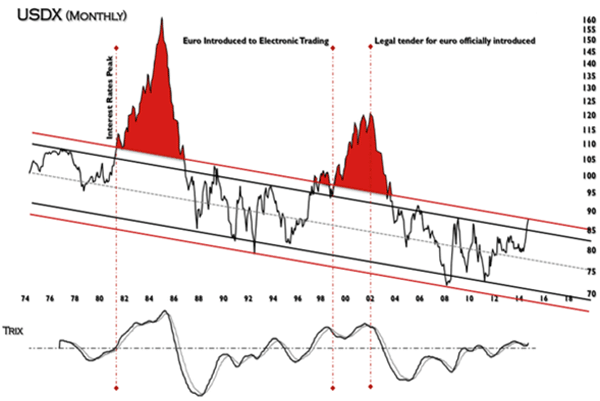
Source: Market Anthropology
The US dollar reached a peak against major currencies in 1985 and fell 52% to a low in August 2011, which, ironically enough, coincided with the S&P rating downgrade. Based on conventional wisdom, the upward movement since then is seen as the start of multi-year mega-uptrend. The argument for broad-based dollar strength is supported by (i) decent US growth, (ii) higher yields than those of its main trading partners, (iii) external balances that are in good shape, (iv) cheap currency valuation on a real effective exchange-rate basis, and (v) deliberate devalutions in the rest of the world.
In general, we are skeptical of the consensus mindset and don’t think that the US dollar can appreciate significantly over the next five years. We view the recent strong run-up in the currency’s value as a cyclical phenomenon – not a secular upturn – and suspect it offers an excellent opportunity for investors to diversify outside of the dollar.
As we analyze our macro signals, we continue to find the bullish narrative directed towards the US economy and the US dollar exceedingly optimistic. Much ink has been spilled to prove American exceptionalism in a slowing global growth environment. But as they write (in fine print) at the bottom of every hedge fund’s fact sheet: past performance is not indicative of future results. The risk of a synchronized global downturn, while not our baseline view, is all too real, with global leading economic indicators (including those for the US) tipping over from their 2014 highs. Based on the Fed’s models, a large appreciation of the dollar is estimated to cut GDP growth by around 0.5% over the following year. As per Ashraf Laidi, the Fed’s priority may be displaced from containing any unwarranted rise in bond yields to that of monitoring the rise of the dollar.
We believe people are greatly overestimating the resilience of the US recovery, especially when we consider the prospect that we may have just seen “peak payrolls.” It is undeniable that the oil and gas sector has become a key driver of US economic activity. According to The Perryman Group, it has been responsible for about 30% of the 10 million national increase in jobs since the global financial crisis. With oil prices plunging, the expected slowdown in drilling and weaker capex spending darkens the job market outlook for the energy sector. It is possible that this will be offset by other parts of the economy that experience an oil windfall, but we would be hesitant to draw such a conclusion, with jobless claims numbers already slowing from a rate-of-change perspective. The labor market usually peaks 7 months in advance of a recession, since unemployment is a lagging indicator. In the coming year, we think the labor market will be demonstrably weaker than indicated by the unemployment rate, as the pace of job growth stalls. This is one of the consequences of the “New Oil Normal” theme we discussed in November. It certainly looks like US 3rd quarter GDP was the peak on a sequential basis. According to BCA Research, the biggest boost from the most cyclical parts of the economy (housing and consumer durables) is already behind us.
One of the less-cited factors for dollar strength is the improvement in the US current account. The chief benefit of QE was the cheapening of the dollar to its lowest level in the postwar era. It was one of a host of factors that led to a decline in the current account deficit from a peak of 6% of GDP in 2006 to about 2% of GDP in 2014. It was partly the reduction in the current account deficit that led to fewer US dollars being available in the international market, thus swelling the dollar’s value. The “short squeeze” on two-thirds of the $11 trillion cross-border loans that are denominated in dollars reversed institutional investment flows back into US, according to Morgan Stanley.
The last time the US had a current account surplus was in 1991, when the trade-weighted dollar was nearly 40% stronger than it is today. So the fact that, even with the dollar’s major undervaluation since 2011, the US has been unable to return to a surplus suggests that the current account deficit is really structural in nature. We believe the dollar is now vulnerable to a rewidening of the current account deficit on the back of stronger household consumption. The temporary fillip to the current account from the shale oil boom, weak import demand, and lower interest rates should reverse in the next five years. The US trade deficit is already back to the record lows seen before the financial crisis in 2008, if we exclude oil. Even with the drop in oil prices, US terms of trade will benefit less due to much lower sensitivity relative to history. It is for this reason that we believe US will struggle to attract the same amount of external capital as it has in the past.
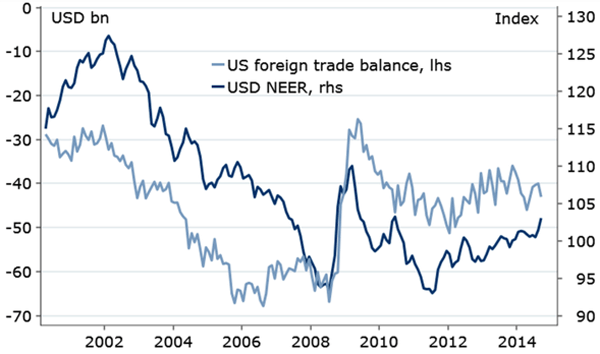
Source: Nordea Markets and Macrobond
Since we don’t employ an army of clairvoyants, we can’t tell you what the exact jobless rate or the Fed funds rate will be a year from now. While we believe that the US economy can withstand non-zero short-term rates at this point, the anomalous divergence between payrolls growth and inflation expectations complicates the way forward. The global macro environment today is beset with deflationary tendencies. Based on our best judgement, monetary policy is unlikely to tighten at the pace it did during the last two cyclical bull markets in the dollar: the early 1980s and the late 1990s.
Inflation, as measured by the personal consumption expenditure (PCE) index, is 1.4% currently, and it has been below the Fed’s target of 2% since April 2012. Measures of long-term inflation expectations based on the CPI swaps market have meanwhile fallen below levels that preceded QE2, QE3, and Operation Twist. The drop has occurred against the backdrop of dollar strength, weakening commodity prices, and slowing global growth. Even the University of Michigan consumer inflation expectations measure has fallen to the lowest level since March 2009, which means both survey-based and market-based measures are indicating the same message. At a bare minimum, this implies the Fed will begin to make more frequent overtures to rein in the dollar.
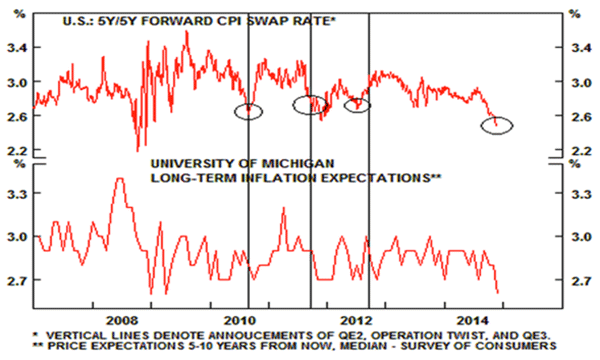
Source: BCA Research
The latest FOMC minutes revealed policymakers will be “attentive” to evidence of a further downward shift in longer-term inflation expectations because it “…would be even more worrisome if growth faltered.” Current market estimates for liftoff now point to Q3 of 2015, and recent comments by Fed Vice Chairman Stanley Fischer suggest the central bank is inclined to start raising rates even if inflation is lower than the Fed’s 2% target. However, if deflation expectations accelerate in the coming year or in the event of any negative growth surprises, we think the Fed will adopt a more relaxed attitude to policy normalization than is currently anticipated. “Premature rate increases would carry a high risk of short-circuiting the recovery” warned former Fed Chairman Ben Bernanke in a March 2013 speech, “possibly leading to an even longer period of low long-term rates.” The folly of a number of central banks that were forced to reverse their decisions later is all too evident to Fed officials, so we don’t expect them to repeat the same mistake.
But even if they do, will rising US interest rates imply a stronger dollar?
By reviewing past tightening cycles, we learned that exchange rates can follow many paths that do not always correspond to the predictions from monetary policy actions. The evidence shows that sustained and large increases in the Fed funds rate can lead to an appreciation of the dollar, but it often takes two years for those effects to take noticeable hold. There is a substantial delay between the policy actions and the maximal effect on the dollar. For instance, the Fed’s last tightening cycle began in mid-2004 when the unemployment rate had fallen to 5.5% and other metrics of the labor market were significantly stronger than they are now. The US dollar fell in the following six months, and by the time of the last rate hike during the summer of 2006, the dollar was at about the same level as when the liftoff began. Over an extended period of time, rising US interest rates are not necessarily accompanied by a rising foreign exchange value of the US dollar. Fed rate hiking since the early 1970s has actually been, on average, consistent with the dollar getting weaker, not stronger.
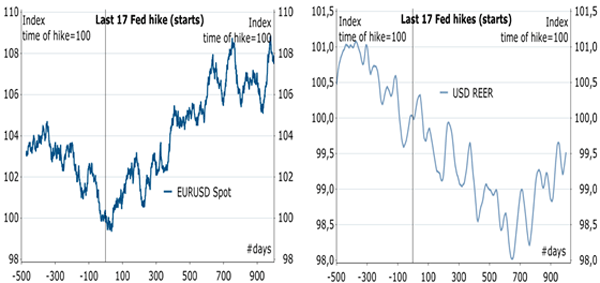
Source: Aurelija Augulyte (Nordea Markets)
At this stage of the business cycle, real interest rates are typically rising as economic activity gathers pace and a self-sustaining recovery takes hold, leading to an adjustment higher in the interest rate path. Yet in our current experience, real interest rates are mostly rising due to the sharp decline in inflation expectations, which in the past has generally been disastrous for asset prices. We interpret this to mean that a stock market correction is a possible “tail risk” in 2015. It used to just be a “risk,” but given its infrequent appearance lately, we would consider it to be a tail event.
As we wrote in our October issue,
The AOL Time Warner merger in 2000 culminated in the tech crash, the Blackstone IPO in 2007 presaged the 2008 financial market meltdown, and the Glencore listing in 2011 marked the peak in iron ore prices and the commodity super-cycle. We can’t escape the feeling that the Alibaba IPO may also be sending an ominous message for future market returns.
In our view, the balance between adequate and sustained growth and financial stability will become more difficult over the foreseeable horizon than has been the case traditionally. If the S&P 500 were to suddenly shed 15 or 20% of its value, how might Yellen react? We don’t believe that volatility can be kept supressed when liquidity provisions are diminishing. Markets are living precariously without the Fed put.
Indeed, if the Fed raises interest rates next year, the Fed will also lower price-to-earnings multiples. As per James Paulsen:
It is difficult to look at the 60-year relationship illustrated in the chart and not conclude that if the Fed begins to raise the funds rate next year, the S&P 500 P/E multiple is likely to decline. Indeed, P/E risk in 2015 is probably further augmented because the current P/E multiple is quite high (i.e., the current P/E multiple is higher than about 70% of the time since 1955) and because it has risen by 50% (from about 12 times to about 18 times) in the last three years! Those expecting the Fed to finally begin increasing the funds rate in 2015 should also anticipate a meaningful decline in the stock market’s P/E multiple…. The ability of earnings to entirely offset Fed tightening seems unlikely. US profit margins are already near postwar highs, and the profit cycle is much more mature compared to past recoveries.
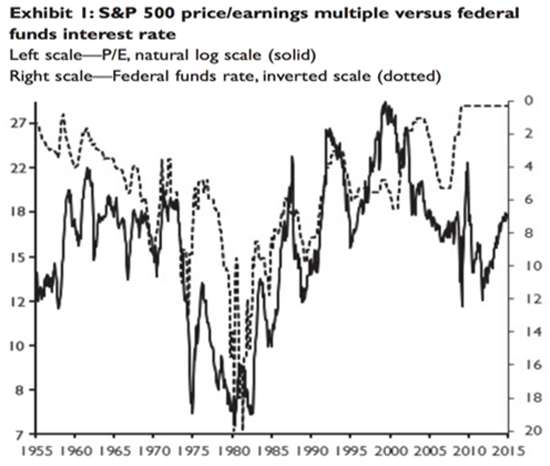
Source: Wells Capital Management
If we assume a 10% decline in the P/E multiple (from about 18 to 16) and multiply that against our expected S&P EPS of $125 next year, we get an index value of 2000 for the S&P 500.
A positive co-movement has developed between the trade-weighted dollar and US stocks, which suggests that the dollar may not be the usual safe haven if equity markets slide.
And if we are correct in our thinking about the dollar, it also means we are nearing the end of US stocks’ outperformance compared with the rest of the world.
We recommend investors to diversify into the euro. We believe aggressive assumptions about the expansion of the ECB’s balance sheet will need to be pared down. In the six months since Mario Draghi first announced plans for fresh stimulus, the ECB balance sheet has actually shrunk by over €100 billion. It is still possible that the QE Rubicon will be crossed in 2015, but there remain plenty of political and legal obstacles before purchases of sovereign bonds can be used as a monetary policy tool. The ECB’s board is divided on the vague plans for a €1 trillion liquidity salvo. In any case, a full-scale QE might not have a lasting downward impact on the euro. According to BCA Research:
In the euro area, the correlation between the stock market and the currency has been consistently and strongly positive. Therefore, while the ECB’s monetary loosening may initially weaken the euro, if it also lifts asset prices, the second-round impact works in the opposite direction. It strengthens the euro.
Meanwhile, the decline in EUR/USD has already priced in a meaningful balance sheet expansion, in our view. Therefore, downside in the euro is limited. We think the end of European bank deleveraging may lead to better growth prospects in 2015, which could reverse the extreme pessimism. Our analysis leads us to conclude that the risk of a major deflationary bust in Europe, while not exaggerated, is likely to recede in the coming months and that economic indicators should improve, even if it takes time.
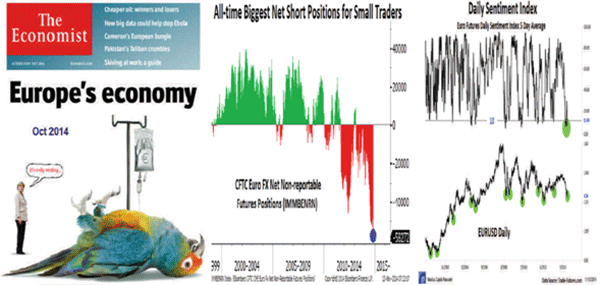
Source: Nautilus Research
Taken as a whole, Europe has some of the strongest fundamentals in the world right now, given the size of its budget deficit; its primary balance; or its current account surplus, which stands at a record €250 billion in the last twelve months. The eurozone’s oil import bill totaled over €300 bn in the last year. As this declines with lower oil prices, it will push the current account surplus to new record highs in 2015. This will underpin formidable support for European assets and should act against any attempts to weaken the currency on a sustained basis.
We feel the situation is no different to what Japanese policymakers faced when they found it difficult to stop the appreciation of the yen during the 1990s. Even though the yen dropped at the start of the Japanese recession, it rallied strongly in the mid-1990s despite numerous efforts to weaken the currency and remained strong throughout the next decade.
The European crisis is also forcing tough fiscal adjustments and structural reforms that will serve to benefit the common currency in the long run. And after Trichet (French) and Draghi (Italian), our speculation is that a German (Weidmann?) will become the next ECB President. Can you imagine the performance of the euro under German diktat?
We also suspect the popular Abenomics trade has likely run its course over the intermediate term. This implies that the Japanese yen may strengthen against the US dollar in a violent countertrend move. This will confound the majority of anlaysts that are racing to keep up with the yen’s decline, with expectations of a further expansion in Japanese QE by June.
It is assumed that the BoJ’s unprecedented balance sheet growth and Abe’s second-term election win will lead USD/JPY to rise even farther and faster in the months ahead. We would caution against such linear thinking. In our view, it is important to pay particular attention to the embedded beliefs in financial markets and assess valuations and trends in this context. It is not necessary that rising total assets on the BoJ’s balance sheet will result in sustained yen depreciation. Between 2002 and 2005, the BoJ’s balance sheet increased by nearly 40%, yet USD/JPY fell from 135 to 100.
We lean on the astute Louis Gave, founder of GaveKal Research, for his shrewd analysis of Japan’s conundrum:
With the Nikkei breaking out to new highs, Abe obviously feels now is the time to try and cement his party’s dominant position in the Diet. But is Abe’s decision really such good news for investors? Doesn’t it suggest that near-term stock market gains may be capped? Obviously Abe, like everyone else, has no clue where the Nikkei will be in six or 12 months time. But if the prime minister had any more market-boosting tricks up his sleeves, wouldn’t he have deployed them first, waited for stocks to rally further, and only then called an election—in which he may have stood a greater chance of winning the two-thirds majority he needs to change the constitution and upgrade Japan’s military, his ultimate goal. The reality of the Japanese equity market in recent years is that it has largely been a play on the yen’s exchange rate. Of course, the yen took another leg down—and the market a leg up—when BoJ governor Haruhiko Kuroda announced another aggressive round of quantitative easing at the end of October. But this latest move begs the question: What will drive the yen weaker from here? Given the BoJ’s aggressive money printing, and the Government Pension Investment Fund’s (GPIF) commitment to invest more abroad, the yen should easily drift down to ¥120 to the US dollar. But beyond that, what will be the catalyst for further yen weakness? The single most obvious catalyst would be the start of a tightening cycle in the US. Historically, the single biggest driver of US dollar-yen exchange rate has been the difference in interest rates. But if the Federal Reserve refrains from raising rates in the near future, then what else could drive the yen lower? In all probability it will not be the BoJ, at least in the near term. After Kuroda put his hand in his pocket last month, it is unlikely he will be called upon to act again until the second half of 2015 at the earliest. More importantly, the combination of the decline in the yen over the last two years, the continued gradual decline in global energy prices, and the very slow restart of Japan’s nuclear plants means Japan’s trade balance is likely to see a net improvement over the next few quarters.”
Finance Minister Aso and former officials like Sakakibara are also getting more concerned about the pace and level of yen devaluation. The exchange rate is now the cheapest versus the US dollar since late 1985. Based on the OECD's measure of purchasing power parity, the yen is undervalued by 15% against the dollar now, compared to an overvaluation of 23% when Abe was elected two years ago. It is the most undervalued of the major currencies.
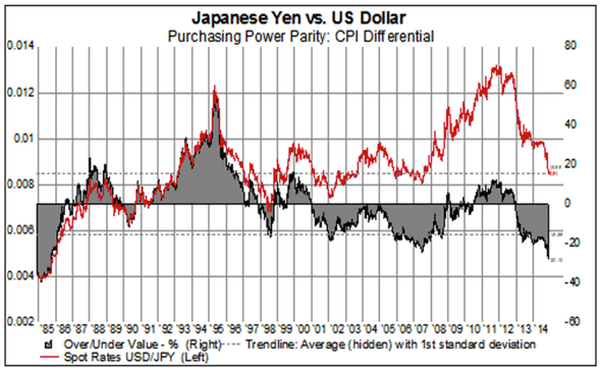
Source: GaveKal Capital
We believe the Abenomics trade will face a critical test in the weeks and months ahead. We are approaching a pretty important turning point, in our view. On December 1st, just as the Nikkei closed at a seven-year high, Moody’s cut Japan’s credit rating to A1 from AA3. Rating agencies are notorious for always arriving late to a party.
We think, rather counterintuitively, that with Japan’s economy now back in recession (Q3 GDP dropped 1.9% year-on-year) and with nearly 85% of all respondents to a recent Kyodo News poll clearly saying they did not feel that the economy has recovered, the yen is about to embark upon a major rally. We would look for a peak in USD/JPY around the 122 area.
Finally, what to do about gold?
Gold peaked in 2011 and has since dropped more than 40%. Is the powerful bull market since 2001 still alive or is gold entering a multi-year decline?
The catalysts for higher prices, which were present for much of the last decade, have clearly diminished: real interest rates around the world are no longer negative, although they will remain low for some time; and central bank policy is not as expansionary, even though competitive devaluations are still in vogue. As the world “looks better,” the price of gold has adjusted down to reduced tail risk across the global macro spectrum. Gold tends to perform quite poorly when real yields are rising, Fed tightening is brought forward, economic surprises are positive, and the equity risk premium is shrinking. Should we see a sharp rise in volatility and fall in asset prices, all of these forces are prone to reverse, and gold should prove to be an effective hedge in that environment. Even if you are worried about the Fed hiking rates next year, keep in mind that gold rallied from 2004 to 2006, even as the Fed funds rate increased.
Anyone interested in a safe haven, or has systemic risk reached a secular crescendo?
The price of gold already appears to have stabilized, despite weak inflation readings and lackluster broad money growth. From a technical perspective, gold is sitting on trend-line support that extends from the November 2001 pivot, with momentum at positive divergence on both a weekly and monthly time frame. We find market extremes in both sentiment and positioning and believe liquidation of gold ETF holdings will soon reach an inflection point. The only factor that has given a reliable signal for gold prices is the US dollar. Based on our discussion so far, we believe the reversal in the dollar will lead gold to recapture some of its lost glitter.
The “no” vote for the “Save Our Swiss Gold” campaign did not come as a shock to us. The proposal, which called for ‘protecting the country's wealth by investing in gold,” was rejected by 78% of the voters. After a three-year bear market, the Swiss can be forgiven for falling out of love with gold. The Swiss National Bank is particularly relieved, as it would otherwise have had to hold at least 20% of its balance sheet in gold reserves, which would make its monetary machinations far more cumbersome. But we really can’t help but wonder whether this decision will be remembered along with the infamous “Brown’s Bottom,” when Britain’s Gordon Brown, then Chancellor of the Exchequer, decided to unload half of the UK’s gold reserves in a series of auctions, at an average gold price of $275 over a span of three years. Will the Swiss eventually look back in anger at possibly passing on a golden opportunity?
The price of gold is up 7% since the vote.
'Tis the Season of Shame
Shortly after I graduated from university, I landed a job as a bank teller in Toronto. It was, surprisingly enough, one of the best things that could have happened to me at the time.
I was pretty shy growing up. I’m not a big talker. I was always the quiet one in our group of friends; I probably still am. But as a bank teller I was forced to interact with everyone: comely girls, creepy men, and cranky old people. Slowly, I began to get comfortable with my role, and with time I gained confidence. It was a small neighbourhood branch, so it had a very sociable atmosphere. The branch manager (Vicky) was Italian, the two personal bankers (Nitee and Niadia) were Indian and Spanish, the financial advisor (Akis) was Greek, and my two side-kicks at the till were Irish (Julian) and Canadian (Kathy). I was there for three months and absolutely loved it.
What I remember most fondly from my experience was the period leading up to Christmas.
I can’t stand the cold. Even after having spent nearly a quarter of my life in Canada, I have never gotten used to the winters there. But for some reason, during each Christmas season, I wouldn’t mind freezing. I think it had much to do with the wonderful holiday spirit.
It was fascinating for me to see the entire city come alive. Trees and malls would be decorated with lovely-looking lights long before snowfall had any chance to cover them in its fold. From November onwards, you could shop till you drop, with big discounts at every store. I would spend from my purse to buy blank cards and gifts for people I worked with. And every morning, as I picked up my “double double” from Tim Hortons, I would smile at the sight of Santa and his reindeer doing the rounds on my coffee cup.
At our branch, the local radio station was always on as background score for our daily activities. In December, all they played were Christmas carols. For the first few days I went mad listening, but as time drew on, I found myself humming along.
My favorite was Chris Rea’s “Driving Home for Christmas” and The Pogues and Kirsty MacColl’s “Fairytale of New York.”
I noticed our customers become friendlier as well. The grumpy old man was not so grumpy anymore, and the harried small business owner found the time to say hello first. As Charles Dickens once observed,
I have always thought of Christmas time, when it has come round, as a good time; a kind, forgiving, charitable time; the only time I know of, in the long calendar of the year, when men and women seem by one consent to open their shut-up hearts freely, and to think of people below them as if they really were fellow passengers to the grave, and not another race of creatures bound on other journeys. I will honor Christmas in my heart, and try to keep it all the year.
Just like my colleagues at the bank, we may all have come from different places, but we all still belong to humanity. No one has exclusivity.
As the late musician Jeff Buckley said, “The soil from America can differ from the soil in Malaysia, but its soil, it’s still the same. And the color of people’s skin can differ from place to place, but it’s still skin. And, in that regard, there is no difference.” We are all but travellers heading to the same destination, even if not in the same direction.
If there is any moral principle that we must understand, it is that humanity is as one single body; and each nation, all races, are the different organs. The well-being of each of those organs determines the happiness and well-being of the entire body. The shame is in not feeling the strain when one organ of the body is in pain. The need of the world today is for a selfless conscience, together with a sense of awakened justice. The world will crumble when all selfless people cease to exist. In many ways, it would appear their number is thinning quite rapidly.
Our welfare is not in looking after ourselves but in looking after others. This season, what we truly need is to give a damn.
In the end we all belong to God, and to Him we shall return.
Jawad
Like Outside the Box?
Sign up today and get each new issue delivered free to your inbox.
It's your opportunity to get the news John Mauldin thinks matters most to your finances.
John Mauldin Archive |
© 2005-2022 http://www.MarketOracle.co.uk - The Market Oracle is a FREE Daily Financial Markets Analysis & Forecasting online publication.



